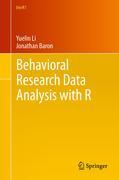
This book is written for behavioral scientists who want to consider adding R to their existing set of statistical tools, or want to switch to R as their main computation tool. The authors aim primarily to help practitioners of behavioral research make the transition to R. The focus is to provide practical advice on some of the widely-used statistical methods in behavioral research, using a set of notes and annotated examples. The book will also help beginners learn more about statistics and behavioral research. These are statistical techniques used by psychologists who do research on human subjects, but of course they are also relevant to researchers in others fields that do similar kinds of research. The authors emphasize practical data analytic skills so that they can be quickly incorporated into readers’ own research. For behavioral research practitioners who are interested in learning R. Provides practical advice on some of the widely-used statistical methods in behavioral research, using a set of notes and annotated examples. Emphasizes practical data analytic skills. INDICE: Introduction. Reading and Transformting Data Format. Statistics for Comparing Means and Proportions. R Graphics and Trellis Plots. Analysis of Variance. Linear and Logistic Regression. Statistical Power and Sample Size Considerations. Item Response Theory. Imputation of Missing Data. Linear Mixed Effects Models in Analyzing Repeated Measures Data. Linear Mixed Effects Models in Cluster Randomized Studies.
- ISBN: 978-1-4614-1237-3
- Editorial: Springer New York
- Encuadernacion: Rústica
- Páginas: 245
- Fecha Publicación: 28/11/2011
- Nº Volúmenes: 1
- Idioma: Inglés
